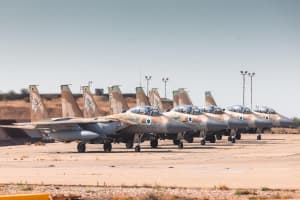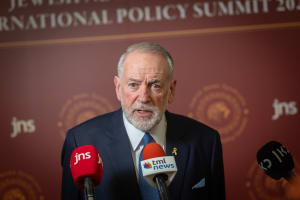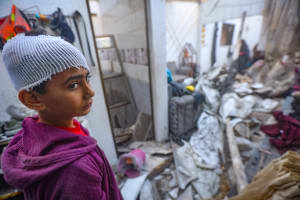The growing threat from Iraq: How Iran's ayatollah regime uses proxy militias to avoid consequences
Iraqi militias sharply increased the number and efficiency of their attacks on Israel

Receiving little attention amid the massive exchange of fire between Israel and Hezbollah these last days, the Iraqi terror group “Islamic Resistance in Iraq,” or the IRI, has become another serious threat to the Jewish state, which is battling enemies on seven fronts.
Late last Sunday, a series of drone attacks in the area of the southern Golan Heights culminated with reports that the IRI had launched a “drone swarm,” activating alarm sirens in the Beit Shean valley, an area that has largely been spared from attacks during the current war.
Shortly before, the IDF said it had intercepted two cruise missiles inbound “from the east.”
While all these threats have been either intercepted or failed to make it to Israeli territory, the launch of cruise missiles and drone swarms signal a new quality of threat on Israel’s eastern border.
The IRI has been launching projectiles at Israel since the start of the war, claiming to support Hamas in a similar way to its Hezbollah and Houthi allies.
In the first months, IRI received sporadic and bemused coverage for outlandish claims of having hit “vital” Israeli targets, while many of its drones didn’t even manage to fly the distance to Israeli territory.
But in recent months, IDF announcements that “aerial threats” from the east had been shot down steadily increased. The group has also been attacking U.S. bases in the regions with drones and rockets.
Behind this phenomenon stands the Iranian regime’s Islamic Revolutionary Guard Corps, and more specifically, its Quds Force.
The close connection between the pro-Iranian militias and the Quds Force was highlighted by the U.S. drone strike in 2020, which killed Quds Force commander Qassem Soleimani together with Abu Mahdi al-Muhandis, then-leader of the Iran-backed militias in Iraq.
The regime aims to make the IRI another one of its tools to be wielded against Israel at will while deflecting direct action against the ayatollahs.
The IRI isn’t a typical terror group – rather, it’s an umbrella group using a Telegram platform to announce strikes against Israel and the U.S., which are being carried out the various Iran-backed militias across Iraq.
Many of these militias were created during the insurgency against U.S. forces in the aftermath of the Iraq war. At the time, the Iranian Quds Force helped create and equip Shia militias in their fight against American forces, as well as other Iraqi militias representing the country’s Sunni and Kurdish population.
In 2014, several militias, most of them Shia, banded together on the initiative of Shia cleric Ali al-Sistani and the Iraqi government to fight against ISIS.
Dubbed the “Popular Mobilization Forces” (PMF), this group integrated numerous militias as brigades and was eventually incorporated into the Iraqi armed forces as a paramilitary force.
Beginning in October 2023, some – but not all – of the militias comprising the PMF began attacking U.S. forces, and then Israel, while using the façade of the IRI Telegram platform to publicize their actions.
The fact that the various groups are working together toward a common objective despite their usual squabbles is a strong indication that the Quds Force is coordinating their actions.
Among the most important member groups are Kataib Hezbollah, Harakat Hezbollah al-Nujaba, Kataib Sayyid al-Shuhada, and Ansar Allah al-Awfiya, all of which have been designated as Foreign Terrorist Organizations and Specially Designated Global Terrorists by the U.S. State Department.
Since October, the IRI has claimed responsibility for over 180 attacks on U.S. forces in Iraq and Syria, and over 115 attacks on Israel.
In response, the U.S. has increased its strikes on the groups in recent months, and according to Syrian reports, Israel killed a senior member of the Kataib Hezbollah group in an airstrike near the Syrian capital of Damascus just last Friday.
The terrorist was killed near the Shia Sayyidah Zaynab Shrine, one of the major strongholds and centers of activity of the IRGC in Syria, underlining the growing integration of the Iranian proxy militias in the region.
As part of this trend, the Iranian regime appears to plan on making Baghdad a central node of its militia network in the region.
In July, the Houthis and Hamas both opened official representative offices in the Iraqi capital, while sources from the Iraqi militias threatened to transfer fighters and weapons to help their ally Hezbollah fight off an Israeli ground invasion.
The emergence of the Iraqi militias as another major threat to Israel threatens to further spread out the Jewish state’s attention and resources.
In addition, it provides the Iranian regime another tool in the box, and possibly a replacement for Hamas and Hezbollah, who may emerge out of the current conflict drastically weakened, if they survive at all.
The Iranian regime continues pursuing its tactic of surrounding Israel with hostile, well-equipped and funded militias.
Their sporadic attacks on Israel are meant to weaken it and provide Iran with deterrence as it races toward a nuclear breakout, all while ensuring the regime itself never directly suffers the consequences of its actions.
The fact that Israel and the U.S. continue targeting Iranian proxies while shying away from attacks on Iranian soil, indicates that the ayatollah’s gamble continues to pay off, at least for the time being.

Hanan Lischinsky has a Master’s degree in Middle East & Israel studies from Heidelberg University in Germany, where he spent part of his childhood and youth. He finished High School in Jerusalem and served in the IDF’s Intelligence Corps. Hanan and his wife live near Jerusalem, and he joined ALL ISRAEL NEWS in August 2023.
You might also like to read this:













